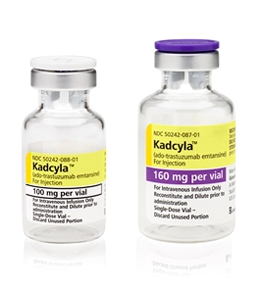

The breast cancer treatments (paclitaxel and Trastuzumab) used in this study are considered part of standard-of-care regimens in early breast cancer. In preclinical studies, this drug has prevented or slowed the growth of breast cancer. T-DM1 has caused cancer cells to die in laboratory studies. However, it FDA-approved for metastatic HER2-positive breast cancer. The use of T-DM1 in this research study is experimental, which means it is not approved by any regulatory authority for the adjuvant treatment of HER2-positive breast cancer. This drug has been used in other research studies and information from those other research studies suggests that this drug may help to prevent the recurrence of breast cancer in this research study. Trastuzumab emtansine (T-DM1) is a drug that may stop cancer cells from growing. It also means that the FDA has not approved this drug for use patients undergoing adjuvant treatment for HER2+ breast cancer. "Investigational" means that the drug is still being studied and that research doctors are trying to find out more about it-such as the safest dose to use, the side effects it may cause, and if the drug is effective for treating different types of cancer. Phase II clinical trials test the effectiveness of an investigational drug to learn whether the drug works in treating a specific cancer. This research study is a Phase II clinical trial. Philadelphia (PA): AACR Cancer Res 2017 77(4 Suppl):Abstract nr OT1-02-03.Sponsor Protocol Number: TBCRC033 About this study In: Proceedings of the 2016 San Antonio Breast Cancer Symposium 2016 Dec 6-10 San Antonio, TX.
#T DM1 CLINICAL TRIALS TRIAL#
Phase I multicenter clinical trial evaluating the combination of trastuzumab emtansine (T-DM1) and non-pegylated liposomal doxorubicin (NPLD) in HER2-positive metastatic breast cancer (MBC) (MEDOPP038 study). To date, four patients (three at DL1 and one at DL2) have been recruited.Ĭitation Format: López-Miranda E, Brain E, Saura C, Gligorov J, Dubot C, Dieras V, Suter TM, Aguirre E, Perez-García JM, Llombart A, Cortés J. Recruitment was opened on September 2015. RECIST v1.1 evaluable disease.Ī total of 12-24 patients will be enrolled at four sites in Spain and France. Adequate organ and cardiovascular function with LVEF ≥ 55%. An expansion cohort of six additional patients at the MTD will be included.Īnthracycline-naïve patients with HER2-positive MBC and up to two prior chemotherapy regimens in the advanced setting who previously were treated with trastuzumab and a taxane. The MTD will be defined as the highest DL at which ≤1 of six patients experiences a DLT during the first two cycles of treatment. However, in case of at least one patient experiences a DLT, three more patients will be treated at the same DL. If none of these patients experiences a DLT, three other patients will be treated at the next DL. The trial follows a modified dose escalation scheme with a 3+ 3 design.A total of three patients will be included in the first cohort and observed for dose-limiting toxicities (DLTs) during the first two cycles of treatment. This is a dose-finding, open-label, non-randomized and multicenter phase I clinical trial of T-DM1 at a fixed dose of 3.6 mg/kg IV in combination with three different dose levels (DL) of NPLD (45, 50, and 60 mg/m 2) IV administered on Day 1 every three weeks. The secondary objectives include 1) safety, with special emphasis on cardiac safety evaluated by left ventricular ejection fraction, high-sensitivity troponin I and B-type natriuretic peptide (BNP) levels, 2) pharmacokinetics, 3) antitumor activity, and the 4) role of single nucleotide polymorphisms of HER2 gene for developing cardiotoxicity. The primary objective of this trial is to determine the maximum tolerated dose (MTD) of the combination of T-DM1 and NPLD in patients with HER2-positive MBC naïve of anthracyclines and previously treated with trastuzumab and a taxane. However, although T-DM1 has shown encouraging antitumor activity in the advanced setting, several strategies to improve T-DM1 efficacy are currently evaluated, including the combination with non-pegylated liposomal doxorubicin (NPLD), considering that: i) doxorubicin is one of the most active chemotherapeutic agents against HER2-positive breast cancer ii) the combination of doxorubicin and trastuzumab induces synergistic antitumor activity in HER2-overexpressing preclinical models and iii) liposomal formulations of doxorubicin have a reduced risk of developing cardiac toxicity. Clinical efficacy and safety of T-DM1 for the treatment of HER2-positive MBC has been assessed in several phase II and III trials and is now considered the standard of care in taxane-and trastuzumab-progressing patients.


 0 kommentar(er)
0 kommentar(er)
